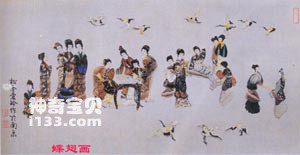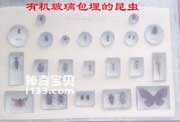Insects such as butterflies, beetles, and dragonflies are deeply loved by people because of their bright colors. There are many art works with butterflies as the theme in the past dynasties. For example, in the Ming and Qing dynasties, the pattern composed of butterflies and melons represented auspiciousness. The combination of butterflies and flowers made the picture vivid and natural, and the paired butterflies represented the symbol of love. The Palace Museum in Beijing houses many famous paintings of the motherland from past dynasties. Among them is a Song painting called "Mu Chun Butterfly Opera". The picture is clear and vivid, with more than ten colorful butterflies, brightly colored and graceful. This painting is said to have been created by Li Anzhong, a painter of the Southern Song Dynasty. The size proportions, morphological characteristics, and color patterns of various butterflies in the painting are mostly similar to the real objects and lifelike. Although thousands of years have passed, it is still possible to identify the butterfly species that were produced near the capital of Lin'an (now Hangzhou) in the Southern Song Dynasty. In some species, the male and female can be clearly and unmistakably identified.

There are even more butterfly patterns that can be seen in fabrics, embroidery, stamps and handicrafts. Papilio butterfly is the best material for arts and crafts. Papilio butterfly specimens can be displayed in various shapes, matched with flowers and plants, and then put into glass covers or photo frames. They can be used as coffee table furnishings and wall decorations. They are very popular in European and American markets. welcome. Artists use the beautiful and colorful butterfly wings to collage them into butterfly wing paintings with high artistic value. There is a butterfly wing painting modeled on the famous painting "Hundred Horses", which is worth as much as 16,700 US dollars. Using the wings of various butterflies as raw materials, taking the advantages of traditional Chinese painting, oil painting and sculpture and other expressive arts, and using the natural patterns of spontaneous combustion of butterflies to collage patterns such as landscapes, scenery, figures, flowers, birds, animals and so on (the picture below is taken from Li Chuanlong’s Book).

Insect-related art can be seen everywhere in our lives, including movies, dramas, calligraphy and painting, handicrafts, etc. The exquisite parts are extremely beautiful. Throughout the ages, there have been many highly artistic coins, in which many insect patterns of different shapes can be seen, such as bees, butterflies, beetles, manganese, ants, cicadas, praying mantises, etc. Insects are said to have been used as symbols of gods in coinage, such as bees representing the goddess Artemis in the temple of Ephesus. According to some statistics, there were more than 300 well-cast insect coins in ancient Greece in the 7th century BC. There were more than 200 species in ancient Rome in 44 BC. However, from Julius Caesar to the 16th century AD, "insect coins" were almost extinct.
animal tags:
We created this article in conjunction with AI technology, then made sure it was fact-checked and edited by a Animals Top editor.